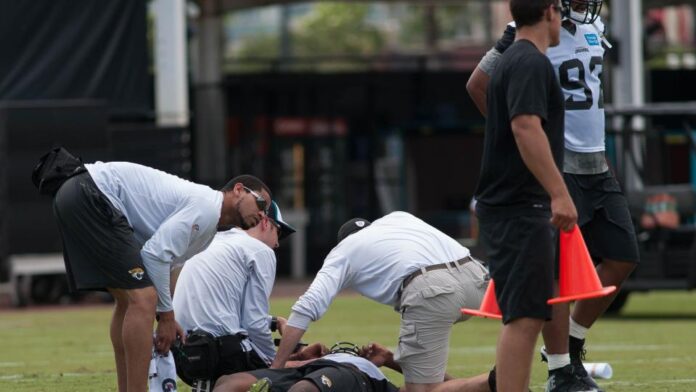From draft into rookie minicamps, accelerated offseason a part of the problem…
Receiving constructive criticism from your coach is not only an integral part of being a player, but it also proves to be highly advantageous.
This is especially true when it pertains to the nuances of a meticulously researched strategy or scheme aimed at exploiting the weaknesses and vulnerabilities of your opponent.
Rookies cannot be expected to fully grasp the demands of NFL play right from the start, and it’s only natural.
Houston Texans head coach Bill O’Brien addressed the subpar conditioning of his players during the rookie minicamp, emphasizing the need for overall improvement in fitness.
He stated on Friday, “We have a lack of conditioning, so these guys need to get in better shape as a whole.”
O’Brien pointed out that one significant challenge faced by his rookies was the sweltering Houston heat.
It’s common knowledge that during this time of year and throughout the summer months, the combination of heat and humidity is the standard in the southern region, contrasting greatly with other parts of the country.
Having grown up in a mountainous area like myself, it’s evident that acclimatizing to such intense heat and humidity requires time, regardless of one’s conditioning level.
While we may not have precise information about the individual conditioning levels of the players O’Brien is addressing, a broader issue I’ve observed concerning rookie conditioning is that the mini-camps are scheduled immediately after the draft, leaving these rookies with minimal time to adapt their bodies to the demands of football.
Training for combined testing doesn’t equate to football training.
While you can attain a commendable level of overall fitness, it’s the unforeseeable nature of movements, the quick reactions, and explosive bursts that occur in actual football plays that most rookies are unaccustomed to preparing for.
Once their final year of college football concludes, rookies often shift their focus towards achieving a swift 40-yard dash time and looking sleek in spandex, akin to track stars.
However, this kind of conditioning differs substantially from the preparation needed for football-specific movements.
Consequently, it’s not surprising that players like Dante Fowler (first-round pick of Jacksonville) and Jeff Heuerman (third-round pick for Denver) experienced early ACL tears in their NFL rookie offseason.
Fowler’s injury, in particular, appeared to mirror a live pass-rush scenario, with his knee giving way as he endeavored to turn the corner while under pressure from the offensive tackle.
These are not situations that can be replicated with weights; rather, they require a gradual re-acclimation to dynamic, resistive movements.
Injuries in football occur in often unforeseeable ways, sometimes due to unpredictable circumstances.
Yet, it’s highly likely that these early injuries result from the players’ bodies not yet having adapted to the specific football movements demanded at the professional level.

For college players, there’s typically a solid month and a half to two months of conditioning post-college season, where the body recuperates from the previous exertions.
Following this, there’s another adjustment period to gear up for football before even donning helmets or pads.
In this regard, the NFL lags behind, a surprising fact given it operates in an industry generating nearly $10 billion annually.
With the compressed offseason schedule due to new CBA restrictions, there’s a perpetual rush to maximize training time.
These players need to absorb new systems and adapt to the lightning-fast pace of NFL play.
Thus, when dealing with rookies who’ve trained more like track stars, it’s imperative to allow them the necessary time to reacclimate to football-specific movements.
Unfortunately, from a coach’s perspective, such time often seems scarce. Consequently, the most significant off-season investments are jeopardized.
Injuries are an inherent risk in football, with some being inevitable.
However, immediately thrusting rookies into mini-camps mere weeks after the draft reflects an outdated NFL mindset that endangers the league’s freshest assets.
At this juncture, why would teams persist in a practice that heightens the risk of injury?
It’s essential to instruct and grant these players the time they need to prime their bodies for football.
I’ve undergone two ACL surgeries on the same knee. Athletes like Adrian Peterson, Jamaal Charles, and numerous others have demonstrated that an ACL injury is not as debilitating as it once was.
For the rookies who recently suffered torn ACLs, there remains a chance they could return to play by the end of this season, particularly with the NFL’s introduction of the injured reserve list.
This allows teams to bring a player back from IR at season’s end, provided they’re sufficiently healed.
This opportunity could allow both rookies to gain valuable experience before the season concludes.
Otherwise, they’ll essentially be starting from scratch in the next offseason, potentially impeding their progress as professional football players.
Coaches are there to guide, and players are there to perform.
For both sides to excel in their respective roles, it’s crucial to approach things with intelligence.
Coaching involves implementing effective strategies for victory.
Presently, a significant challenge to sound strategy lies in the early NFL calendar.
Establishing a foundation before entering the football phase—perhaps even prior to simulated football, as is intended in this new era of offseason workouts—represents the most beneficial approach for everyone’s improvement.
Most importantly, it offers the players the best chance of remaining available for the season.

